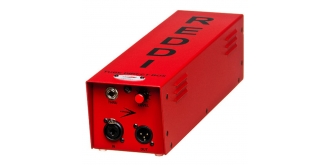 Agrandir l'image
Agrandir l'image
ALL TUBE DIRECT BOX
The Finest DI on the Market • Unbelievable Tube Tone
- All-tube direct box with custom output transformer.
- Ultra wide frequency range (20Hz-60kHz).
- Neutrik input connector, balanced XLR out, and 1/4” thru jack.
- Inspired by the Ampeg B-15.
- Clean and airy high end, warmth, transparency, and ultra high-quality sound.
- Level control.
- Ground lift.
- Ultra bright blue LED on/off lamp.
- Zero-feedback loop design.
- Massive, custom-wound transformers.
- 6NI-P tube.
- Low-Z, transformer-balanced output.
- Frequency Response 20Hz – 60kHz
- Input impedance: 1M ohm
- Gain range: 16dB
- Noise (EIN): -126dB
- Output impedance: 600 ohm
- Maximum level: +22dBu
- Distortion THD: > .08 @ 1kHz
- Power Requirements: 100/120/230VAC – 42W .
- Dimensions (W x H x D) 3-1/2” x 3-1/2” x 14-1/2”
- Weight 10 lb. (4.54 kg.)
ADESIG512G
Nouveau
A-DESIGNS - REDDI

The number of A-Designs REDDIs in use on stages and studios all over the world is nothing short of staggering. Quite simply, there just is no better sounding way to convert an instrument or line level signal to XLR. Designed with the help of top studio engineers and bass players, REDDI has been widely praised by engineers and bassists all over the world as the best-sounding DI solution on the market today.
It is important to note that the REDDI is not a high-gain device! Its gain structure has been painstakingly engineered to avoid the slightest compromise in sound quality. Inspired by the glorious sound of the Ampeg B-15 tube bass amp, REDDI's 6N1-P tube-driven amplifier feeds signal directly into a hefty custom output transformer by Cinemag - a key component to providing a harmonically rich tone. REDDI'S extremely wide frequency range (20Hz to 60kHz) prevents in-band phase shift, resulting in outstanding detail and realism. Another major benefit of its wide bandwidth is the prevention of LF phase shift by maintaining a linear response extending below the audible bass range, insuring a full, natural sound.
REDDI'S distinctive bright red steel chassis sports a front-panel Neutrik XLR/1/4" combo input jack, balanced XLR output, and a 1/4" thru-put, for sending signal to a bass amp - not only useful for live applications, but also for simultaneously recording direct and miked amp tracks in the studio. A 0-16dB-Level control and a bright blue LED power indicator complete the front panel controls. On the back panel are heavy-duty toggle switches for power and ground lift, along with the IEC power outlet.
The REDDI's all-tube circuitry will enhance the character of any electrified instrument run through it - not just bass! Plug the pickup of an acoustic guitar through REDDI to add depth and fullness to its tone. Capture and improve all the richness and life of an electric piano or analog synthesizer. Warm up sterile sounding digital keyboards or drum machines by strapping a REDDI across their output - or two, for stereo! The uses are literally endless?
?.but don't just take our word for it. Here are a few comments from some of the people who actually use it:
Features And Specs
ALL TUBE DIRECT BOX
The Finest DI on the Market • Unbelievable Tube Tone
- All-tube direct box with custom output transformer.
- Ultra wide frequency range (20Hz-60kHz).
- Neutrik input connector, balanced XLR out, and 1/4” thru jack.
- Inspired by the Ampeg B-15.
- Clean and airy high end, warmth, transparency, and ultra high-quality sound.
- Level control.
- Ground lift.
- Ultra bright blue LED on/off lamp.
- Zero-feedback loop design.
- Massive, custom-wound transformers.
- 6NI-P tube.
- Low-Z, transformer-balanced output.
- Frequency Response 20Hz – 60kHz
- Input impedance: 1M ohm
- Gain range: 16dB
- Noise (EIN): -126dB
- Output impedance: 600 ohm
- Maximum level: +22dBu
- Distortion THD: > .08 @ 1kHz
- Power Requirements: 100/120/230VAC – 42W .
- Dimensions (W x H x D) 3-1/2” x 3-1/2” x 14-1/2”
- Weight 10 lb. (4.54 kg.)





